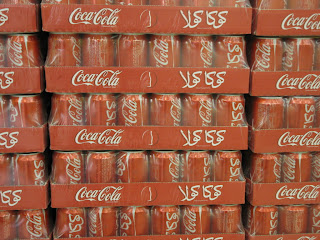
The new alphabet and language gives us the very odd sensation of being illiterate. After shopping one day, we pulled out the receipt to check a price, only to find ourselves staring quietly at a long list of Arabic script. Even if we knew the name of the item in Arabic (doubtful), it would be a slow and arduous process of sounding out each miniscule line to find it. However, I do love the script and I enjoy reading it slowly, sounding it out as if I were Misha learning to read Dr. Seuss. But it will take a little time.
Arabic is not Indo-European, like most of the other languages we have studied, including Spanish, French, German, and Russian. Arabic is semitic, so words are completely different - and a bit hard to remember at first. Take fruits: in Arabic, apple is "tuffah," strawberry is "faroula," and orange is "burtucal."
Another difference that I discovered only shortly before arriving is the numbers. Even though "Arabic numerals" refer to the typical 0 - 9 figures we are familiar with, they are not really Arabic. They come from India, but are called Arabic because the Arabs of North Africa introduced them to Europe in the 10th century. Numbers here are written like so:
٠١٢٣٤٥٦٧٨٩
0 1 2 3 4 5 6 7 8 9
The Middle East uses these Eastern Arabic numerals, which are not difficult in themselves, but are disorienting because many of them look like a different number in our familiar set. for example, a backwards three is really the number four; the circle that looks like a zero really stands for five; and the figure that looks strikingly like a seven is not a seven but a six.
In stores, prices are usually written in both types of numbers, as you can see in this stack of size four (see that backwards three?) diapers. The price, 58.50, is written both ways. As you continue browsing the photos in this post, you'll find many numbers. To give you an idea of prices, one dollar is worth 3.75 Saudi Riyal. I divide by four to get a rough estimate of a price in dollars.

Another adjustment has been to the work week. The first day of work starts on Saturday, and the last day of work is on Wednesday, with the weekend on Thursday and Friday. This shift of the working days has caused us a bit of confusion - we talk of "Friday," but in reality the day is Wednesday. We accidentally call Monday a "Wednesday," because it is the middle of the work week. I'm sure eventually it will begin to feel more normal!
On top of that, Saudi Arabia uses the Hijri calendar, a lunar calendar that is 11 days shorter than our Gregorian one. That means that the 12 Hijri months do not line up with our 12 months, which is why the month of Ramadan, for example, appears to "move around" on our calendar. As with many other things, Saudi Arabia works in both systems, often dating documents both ways. In the Hijri calendar, the current month is Rabat II and the year is 1431. (The first year of the Hijri calendar corresponds to the migration of Muhammad from Mecca to Medina.) Each month begins with a new moon, which waxes to full in the middle of the month, and wanes again to new moon by the beginning of the next month.
Grocery Store Explorers:
Last week, Misha and I (and sleeping Sebastian) took a leisurely trip to the grocery store to check out the unique items available.
 Bags and bags of very cheap spices created an aroma that Misha wasn't too sure about.
Bags and bags of very cheap spices created an aroma that Misha wasn't too sure about. Coconuts, figs, and papayas!
Coconuts, figs, and papayas! Avocados, pears, pineapples, figs, and green almonds.
Avocados, pears, pineapples, figs, and green almonds. Coca Cola, or in Arabic, it's more like Kuka Kula.
Coca Cola, or in Arabic, it's more like Kuka Kula. Checking out the cheeses.
Checking out the cheeses. Misha called these "snowman carrots" because they are perfect for noses. :)
Misha called these "snowman carrots" because they are perfect for noses. :)So much food is imported from all over the world. That means we can find great French cheeses and my favorite European yogurts. Most of the baby food section comes from France, so at least it's easy to tell what I'm buying for Sebastian. We even found good old Campbell's Tomato Soup - so we've been making grilled cheese and tomato soup for Misha, just like at home.
 Pancakes and milk in Arabic.
Pancakes and milk in Arabic.
3 comments:
Wow, that is a lot of change to get used to! Best of luck, I'm sure it will all seem normal in no time. :) Or at least after a year, in which case you'll probably want to sign on for year two I'd bet.
Thanks so much for explaining how everything works. It makes feel as if I were right there with you all. I wouldn't be sure about those spices either. Is French cheese better?
The fruits and vegetables look great! The stores all look modern and nice. Thanks for all the pics on the blog. -mom
Post a Comment